Please complete and submit the form to request your green cart!
Green Cart Tips
Compostable organics are banned from landfills. To help residents keep compostables out of regular garbage, green carts have been in use since 1999. Store the green cart outside and use a mini-bin in your kitchen. If you receive an OOPS! sticker, it means there are non-compostable items (like diapers or plastic) in your cart. Carts come in two sizes: large (240L) and small (140L). Mini-bins can be bought for $5 or $10 at the Valley Waste office and Lawrencetown Transfer Station. COLLECTION STARTS AT 7AM.
How heavy can my cart be?
The maximum cart capacity is 220 lb (100kg). Carts exceeding this weight cannot be lifted by the hydraulics on the collection truck.
What bags can I use?
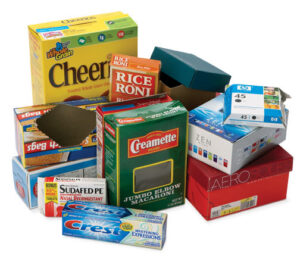 Compost can be put in empty boxboard containers (i.e. cereal boxes).
Compost can be put in empty boxboard containers (i.e. cereal boxes).
- Paper bags may be used for compost.
- Film ‘compostable’ bags may be used for compost provided they are identified by one of these symbols:
 Please refer to our PDF guide for more information.
Please refer to our PDF guide for more information.
Cart Care and Ownership
Carts belong to Valley Waste and are linked to properties by their serial numbers. Contact us if you have extra carts to return. Allow three to four weeks for new cart delivery. When selling your home, leave assigned carts for the new residents. Carts will not be replaced if dirty; owners must clean them regularly. Prospective buyers should check the green cart’s condition. Contact Valley Waste if your cart is lost or needs repair or replacement. Do not alter the carts in any way.
WARNING: Don't put ashes in your green cart
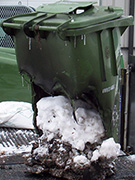 Ashes put in the green cart can cause a fire. Ashes are generally fine for your backyard compost pile. If you are unable to put ashes in your garden, put ashes outside until they are cold before putting them a clear garbage bag for collection. Do not put ashes in your green cart as they could contain metal pieces or other items.
Ashes put in the green cart can cause a fire. Ashes are generally fine for your backyard compost pile. If you are unable to put ashes in your garden, put ashes outside until they are cold before putting them a clear garbage bag for collection. Do not put ashes in your green cart as they could contain metal pieces or other items.
How can I control Pests?
 Drivers will not tip a cart that is secured with bungee cords. To deter raccoons and other animals we suggest using a heavy rock or brick to hold the lid down. In more rural areas building a storage box at the end of the driveway to store your green bin and bags in can also be a solution. Repellents such as cayenne pepper or baby powder sprinkled around the cart may also help deter pests. Adding a No-Pest strip to the inside of your bin can also help to repel insects.
Drivers will not tip a cart that is secured with bungee cords. To deter raccoons and other animals we suggest using a heavy rock or brick to hold the lid down. In more rural areas building a storage box at the end of the driveway to store your green bin and bags in can also be a solution. Repellents such as cayenne pepper or baby powder sprinkled around the cart may also help deter pests. Adding a No-Pest strip to the inside of your bin can also help to repel insects.
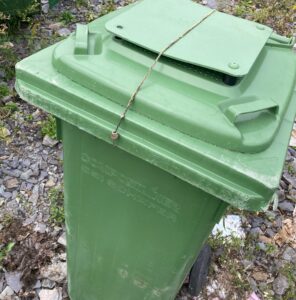 It is also important to not overfill the cart so that the lid will close properly. If using a bungee, remove it from the cart on collection day. The primary cause of odours and insects in the compost cart are meat and fish as well as excess moisture from fruit, vegetables and grass clippings. Using boxboard to contain kitchen scraps is helpful. Table salt, hydrated lime, coffee grounds or baking soda can be used to absorb moisture and/or reduce odours and pests.
It is also important to not overfill the cart so that the lid will close properly. If using a bungee, remove it from the cart on collection day. The primary cause of odours and insects in the compost cart are meat and fish as well as excess moisture from fruit, vegetables and grass clippings. Using boxboard to contain kitchen scraps is helpful. Table salt, hydrated lime, coffee grounds or baking soda can be used to absorb moisture and/or reduce odours and pests.
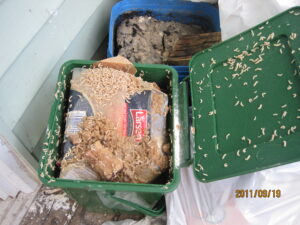 During the summer months, flies and maggots can be a problem. If you encounter this:
During the summer months, flies and maggots can be a problem. If you encounter this:
- Put your cart out to air and dry in the sunshine.
- Cleaning your cart out on a regular basis can also help to alleviate odours which attracts animals and pests.
- Lining your bin with a compostable paper bag helps keep your bin dry. Please refer to our PDF guide for more information.
Rat Tips
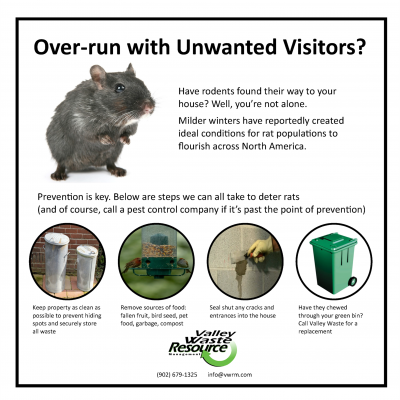
- Wrap your food in newspaper or box board to help reduce odours. You can also freeze smelly foods like seafood and dispose of it on collection day. Putting your cart out for every collection, even if it is not full, can help reduce the attraction of rodents.
- Rats love small, dry, dark, and warm places to hide. Give carts and their surrounding area a good wash with disinfectant. This will make it less likely for the rats to stick around.
- Cleaning up yard debris and potential nesting areas also gives them no place to hide! Restricting access to food and shelter will make your home less hospitable to rats and other vermin.
- Rats have a very sensitive nose, which they use to find food, but it can also be used to deter them. Here are some more repellent remedies:
- Ammonia
- Peppermint oil
- Castor oil
- Citronella oil
Soak several cotton balls in whatever oil or chemical you’re using, and tuck them in and around your garbage cans and other places you may expect to find rats.
How do I reduce and control odours?
Odours in organic materials come from the breakdown of those materials in the absence of air, which releases gases like sulfur and nitrogen. To reduce odours, keep organic materials dry and allow air circulation. You can lower moisture in your cart by using boxboard boxes, such as cereal boxes, for compostables. Line your kitchen bin with paper bags or towels. For smelly items like meat and fish, place them in a cereal box or wrap them in two or three sheets of newspaper to contain the smell. You can also use empty sugar or flour bags for cat litter or compost items to help control odours.
 You can keep items in your fridge or freezer until collection day. To reduce smells in the compost cart, sprinkle hydrated lime, baking soda, or coffee grounds on the material. Wrap meat, bones, fish, and cat litter in used paper towels. Store the carts in a shady spot and clean them regularly with water and detergent or vinegar. When the cart is empty, put some loosely balled-up newspaper at the bottom to soak up any liquid. Use only enough paper to absorb the liquid, as thick layers can restrict airflow.
You can keep items in your fridge or freezer until collection day. To reduce smells in the compost cart, sprinkle hydrated lime, baking soda, or coffee grounds on the material. Wrap meat, bones, fish, and cat litter in used paper towels. Store the carts in a shady spot and clean them regularly with water and detergent or vinegar. When the cart is empty, put some loosely balled-up newspaper at the bottom to soak up any liquid. Use only enough paper to absorb the liquid, as thick layers can restrict airflow.
Winter care for my cart
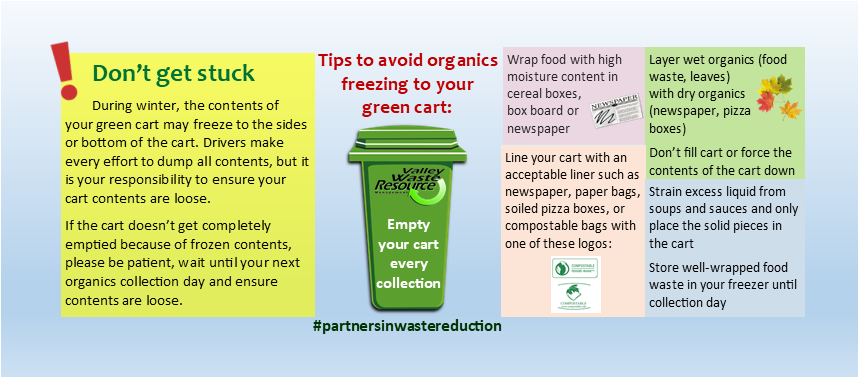
Drivers often struggle to empty carts fully due to contents freezing to the bottom from excess moisture. To combat this, try placing balled-up paper or spraying the cart with cooking spray to prevent sticking. Wrapping food waste in paper products like cereal boxes or using compostable paper bags can also help reduce moisture.
When setting out carts, ensure they are not stuck in snow banks or on icy surfaces. Position carts no further than 15 feet from the curb, maintaining at least one metre clearance around them and two metres above for safe access. Carts placed behind or on snow banks will not be collected.

